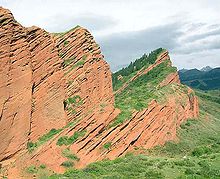Geology of Kyrgyzstan
This articlerelies largely or entirely on asingle source.(October 2018) |

Thegeology ofKyrgyzstanbegan to form during theProterozoic.The country has experienced long-running uplift events, forming theTian Shanmountains and large, sediment filled basins.[1]
Geologic History, Stratigraphy and Tectonics
[edit]The Precambrian tectonic evolution of the region is poorly understood. Geologists infer that the Northern Turkestan domain likely formed along the margin of theProterozoicBaltica-Siberia continent. The Tarim Block may have belonged toGondwanaland,based on paleontological evidence. Although paleomagnetic data for the Tien Shan mountains is lacking, some have suggested that the ocean closed to form the Turkestan domain may have been a branch of the proto-Pacific Ocean. ThePaleozoicrocks in the Tien Shan mountains are the remnants of accreted island arcs, mainly from theOrdovicianonward.
During theVendian,the Northern Turkestan domain was part of the Kipchak island arc system between the East European and Siberian continent, separated by the Terksey back-arc basin which had originated as a rift basin. The Tien Shan mountains began to form in the Ordovician out of three island arcs amalgamated by the subduction of Terksey oceanic crust beneath the Kungey Arc, Sandalash Arc and subduction of Paleotethys Ocean crust under the Yagnob Arc. The Kyrgyz Block formed in the middle Ordovician with closure of the Terksey Basin and then underwent deformation. Coarsemolassesediments lie unconformably on top of subduction-related granite intrusions and volcanic rocks. North and south of the Terksey Suture, formed during the event, late Ordovician collision-related granites.
Into theSilurian,the Sandalash magmatic arc remained along the southern margin of the Kyrgyz Block. Turkestan oceanic crust was subducated beneath the Sandalash magmatic arc. By the earlyDevonian,magmatic activity was taking place in the northern Tien Shan mountains, likely as a result of the subducting Turkestan crust. Sedimentation occurred in shallow seas and on the passive margin of the Tarim-Alay Block.
Magmatic activity resumed in theCarboniferous,with spreading in the Turkestan Ocean and renewed subduction under the Kyrgyz Block. By the late Carboniferous, collision between the Tarim-Alay microcontinent and the Kyrgyz Block was underway, emplacing largenappefeatures withophiolitedeposits on top of the Tarim-Alay basement rocks. Magmatism continued through thePermianin the Tien Shan mountains, accompanied by deformation and the deposition ofmolassesediments in different basins.[2]
Structural geologists distinguish a number of tectonic features from the Paleozoic including the Nikolaev's Line, Talas-Fergana Fault, Turkestan Suture and Terskey Suture.
Mesozoic-Cenozoic (251 million years ago-present)
[edit]At the start of theMesozoic,depressions began to develop in theTriassic,accumulating thick, coal-bearing sediments. The East Fergana pull-apart basin aligned along the Talas-Fergana Fault. The western edge of the basin has delta sediments while the center of the basin reflects deep water sediments. Material and fossils continued to accumulate into the Jurassic as the units were folded.
A shallow water basin covered the region in theCretaceous,leaving behind salt water fauna west of the Talas-Fergana fault. Alluvial deposits mark the edges of the saline lake and Cretaceous deposits accumulated up to 500 meters thick. The lake became a shallow intracontinental sea, lasting into theCenozoic.Lagoon deposits accumulated through theEocene,until the sea began to retreat in latePaleogenetimes. The retreat was brought on with the collision of India with Asia around 50 million years ago. Cretaceous-Eocene sedimentary rocks are up to two kilometers thick in the Fergana Basin. TheOligocene,the entire region had shifted to lagoon and continental deposition.
To the east of the Fergana Range, there are no Cretaceous orPaleocenesediments. Continental sediments accumulated there beginning in the Eocene, formed clay, siltstone and sandstone, interbedded with thinner layers of gypsum, marl, conglomerate and limestone in river valleys formed in the central Tien Shan Mountains in the Oligocene andMiocene.These deposits range widely from several meters thick to several kilometers. They reach their greatest thickness of four kilometers in Fergana, Atbashi and Naryn basins. Tien Shan mountain rocks show no signs of folding from the Cretaceous through the Paleogene and lie with an angular unconformity atop basement rocks.
Tectonic activity rapidly resumed in the latePliocene,leading to erosion of continental sediments into intermontane basins into theQuaternary.Folding developed into theQuaternaryin the Tien Shan mountains as global changes in climate brought on thePleistoceneice ages. Most ridges in the mountain range are asymmetric anticlines bounded by reverse and thrust faults. Folding and thrusting is often oriented toward major basins like the Fergana, Chur or Tarim basins.[3]
Seismic activity
[edit]Due to tectonic activity since the Pliocene, Kyrgyzstan has intense seismic activity on a regular basis. There have been more than 11 earthquakes magnitude 6 or greater on theRichter scalesince 1865. The most activity centers on the Kyrgyz Ranges, Kungey Ranges and East Fergana region.
Natural resource geology
[edit]Kyrgyzstan is notable for significant deposits of antimony and mercury, such as the Chauvay, Kadamzhai and Khaydarkan deposits. These are examples of quartz-fluorite-antimonite-cinnabar (also known asjasperoidtype deposits), while others are quartz-dickite-cinnabar or magnesian-carbonate-cinnabar (or listvenite)_ types. The primary types of deposits are common at the contact between Carboniferous limestone and overlying Silurian shales and Devonian sandstonenappeformations. Listvenite deposits are typically associated withserpentinemélange. Contact metamorphism skarn deposit gold, hydrothermal gold,pegmatitehosted tin, cassiterite-quartz and iron ore in Proterozoic slates are also common together, with smaller amounts of zinc, aluminum, lead, vanadium and uranium.
Oil and gas are found in commercial quantities in the Fergana Basin in Jurassic, Cretaceous, Paleogene and Neogene sedimentary rocks. The oil is low in sulfur and the natural gas is dry with up to 72 percent methane. The South Fergana Basin, the Uzgen Basin, Kavak Basin and Southern Issyk Kul Basin all host coal deposits from the Triassic and Jurassic formed under continental conditions, with 70 percent hard coal.[4]
References
[edit]- ^Moores, E.M.; Fairbridge, Rhodes W. (1997).Encyclopedia of European & Asian Regional Geology.Springer. pp. 483–490.
- ^Moores & Fairbridge 1997,p. 488.
- ^Moores & Fairbridge 1997,p. 490.
- ^Moores & Fairbridge 1997,p. 491.
